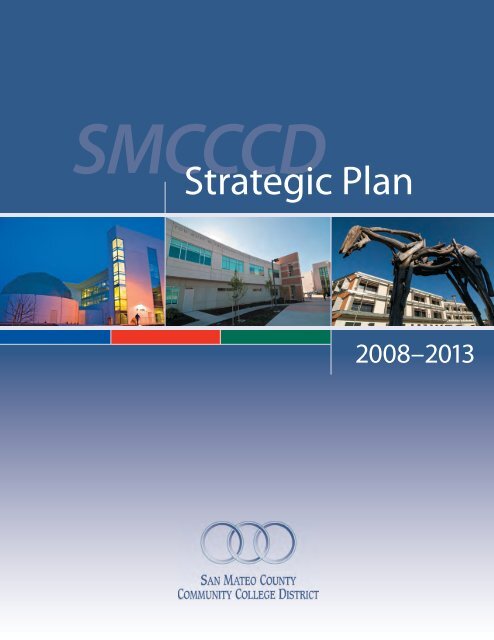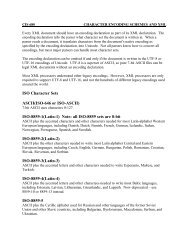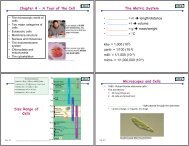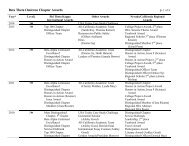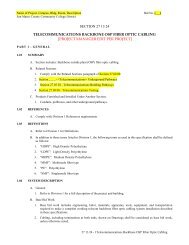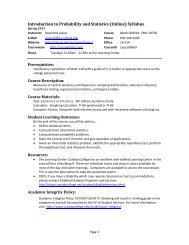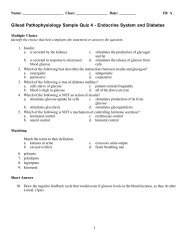Strategic Plan - San Mateo County Community College District
Strategic Plan - San Mateo County Community College District
Strategic Plan - San Mateo County Community College District
Create successful ePaper yourself
Turn your PDF publications into a flip-book with our unique Google optimized e-Paper software.
SMCCCD<br />
<strong>Strategic</strong> <strong>Plan</strong><br />
2008–2013
You are reading a condensed version of the 2008–2013 <strong>San</strong> <strong>Mateo</strong><br />
<strong>County</strong> <strong>Community</strong> <strong>College</strong> <strong>District</strong> <strong>Strategic</strong> <strong>Plan</strong>.<br />
To obtain the complete 2008–2013 <strong>San</strong> <strong>Mateo</strong> <strong>County</strong> <strong>Community</strong><br />
<strong>College</strong> <strong>District</strong> <strong>Strategic</strong> <strong>Plan</strong>, including the Environmental Scan, or if you<br />
need more information or additional copies of the 2008–2013 <strong>San</strong> <strong>Mateo</strong><br />
<strong>County</strong> <strong>Community</strong> <strong>College</strong> <strong>District</strong> <strong>Strategic</strong> <strong>Plan</strong>, please contact<br />
Jing Luan, Ph.D., Vice Chancellor, Educational Services & <strong>Plan</strong>ning,<br />
<strong>San</strong> <strong>Mateo</strong> <strong>County</strong> <strong>Community</strong> <strong>College</strong> <strong>District</strong>,<br />
3401 CSM Drive, <strong>San</strong> <strong>Mateo</strong>, CA 94402.<br />
Email: luan@smccd.edu or call: 650.358.6880<br />
You may also check our plan’s website at<br />
http://www.smccd.edu/edservplan/ssp<br />
for up to date information and additional resources.
A Word from the Chancellor<br />
Since early 2007, more than 25 individuals representing faculty, students,<br />
staff and administrators have directly participated on the <strong>District</strong> <strong>Strategic</strong><br />
<strong>Plan</strong> Taskforce. Hundreds more have been involved in the planning efforts<br />
that impact the future of the <strong>College</strong>s of <strong>San</strong> <strong>Mateo</strong> <strong>County</strong> <strong>Community</strong><br />
<strong>College</strong> <strong>District</strong>. Many meetings, internal and external to our <strong>District</strong><br />
<strong>College</strong>s, were held to debate, revise and adopt this <strong>District</strong> <strong>Strategic</strong> <strong>Plan</strong><br />
(2008-2013). The document that has been developed through this highly<br />
participatory process represents our collective thoughts and shared vision<br />
regarding the <strong>District</strong>’s future.<br />
As you review this document, you will notice that in order to effectively<br />
and efficiently meet the challenge of the coming years, we have created an<br />
integrated planning system for our <strong>District</strong> that is based on a culture of<br />
evidence, shared governance, and a belief in providing the highest quality<br />
education to our students. The plan itself clearly reflects a commitment by<br />
faculty, staff, students, administrators, and the Board of Trustees to achieve a<br />
new level of educational excellence. The attainment of our plan will require<br />
the cooperation of all of us.<br />
Our charge is to create a new educational environment that reflects and responds to the needs of students at the<br />
dawning of the 21st century.<br />
I’m delighted to present the <strong>District</strong> <strong>Strategic</strong> <strong>Plan</strong> that will guide our <strong>District</strong> in the coming years.<br />
Ron Galatolo<br />
Chancellor<br />
SMCCCD <strong>Strategic</strong> <strong>Plan</strong><br />
i
Co-Chairs’ Note<br />
The <strong>San</strong> <strong>Mateo</strong> <strong>County</strong> <strong>Community</strong> <strong>College</strong> <strong>District</strong> <strong>Strategic</strong> <strong>Plan</strong> (2008-2013) was developed amidst rapidly<br />
changing demographics in our region, the state, and throughout the nation. It is being presented during an epic<br />
worldwide economic downturn as well as an historical moment in American political history: the election of the 44 th<br />
President of the United States of America, Barack Obama.<br />
The data-driven approach of the <strong>Strategic</strong> <strong>Plan</strong>ning Taskforce helped us to sharpen our focus on critical goals,<br />
well-defined objectives, and measurable outcomes. This comprehensive strategic document will guide the <strong>District</strong><br />
in dealing with a great number of challenges and in successfully moving toward a higher level of educational excellence.<br />
Finally, the integrated planning model will increase coordination and collaboration both internally within and<br />
among our <strong>District</strong> <strong>College</strong>s, and externally with our community and business partners.<br />
As you review this document, we hope you will appreciate the tremendous work accomplished by the <strong>Strategic</strong> <strong>Plan</strong>ning<br />
Taskforce. Over the course of two years they devoted a significant amount of time and energy to this project,<br />
which represents a memorable achievement in our <strong>District</strong>’s history. Their names appear on the following page.<br />
We would like to thank the faculty, staff, students, and administrators who fine-tuned the plan by taking part in open<br />
forums at the three <strong>College</strong>s as well as all of the external partners who reviewed the drafts. We would particularly like<br />
to thank Presidents Thomas Mohr, Michael Claire, and Victoria Morrow; Executive Vice Chancellor Jim Keller;<br />
Vice Chancellor Harry Joel; Vice Chancellor Marilyn McBride; Vice Presidents Lori Adrian, Susan Estes, Jennifer<br />
Hughes, Regina Stanback Stroud, and Phyllis Lucas-Woods; <strong>District</strong> CFO Kathy Blackwood; and Director of<br />
<strong>Community</strong> and Government Relations Barbara Christensen for their feedback and support. A word of appreciation<br />
goes to Professor Lisa Palmer for editing the final document; David M c Lain for the professional format and graphics;<br />
Sue Harrison for quietly and effectively managing the planning process; and Ginny Brooks, Suki Chang, and<br />
Cristina Cruz for their invaluable assistance. Additional thanks go to the <strong>District</strong> Shared Governance Council; <strong>District</strong><br />
and <strong>College</strong> Academic Senates, Classified Senates, and Student Senates; and the <strong>District</strong> Research Council. And most<br />
gratefully, we thank the Board of Trustees and Chancellor Ron Galatolo for their guidance and confidence.<br />
This plan is intended to be a living document. In that light we will revisit our assumptions and recommendations<br />
regularly, and we look forward to hearing your thoughts and suggestions. We hope that you find this plan useful in<br />
your work with the <strong>District</strong>.<br />
Patty Dilko, Ed.D.<br />
Co-Chair<br />
Professor Early Childhood Education<br />
<strong>District</strong> Academic Senate President<br />
Jing Luan, Ph.D.<br />
Co-Chair<br />
Vice Chancellor, Educational Services & <strong>Plan</strong>ning<br />
ii<br />
SMCCCD <strong>Strategic</strong> <strong>Plan</strong>
SMCCCD Board of Trustees<br />
Richard Holober, Board President<br />
Karen Schwarz, Board Vice President-Clerk<br />
Helen Hausman<br />
Dave Mandelkern<br />
Patricia Miljanich<br />
Virginia Medrano Rosales, Student Trustee<br />
Chancellor Ron Galatolo, Board Secretary<br />
SMCCCD <strong>Strategic</strong> <strong>Plan</strong> Taskforce<br />
(2008–2009)<br />
Jeremy Ball<br />
Kathy Blackwood<br />
Carla Campillo<br />
Suki Chang<br />
Michael Claire<br />
Patty Dilko, Co-Chair<br />
Mauricio Flores Hernandez<br />
Ron Galatolo<br />
Ulysses Guadamuz<br />
Sue Harrison<br />
Rob Johnstone<br />
Nick Kapp<br />
Adolfo Leiva<br />
Jing Luan, Co-Chair<br />
Thomas Mohr<br />
Victoria P. Morrow<br />
Joan Murphy<br />
Martin Partlan<br />
Bart Scott<br />
John Sewart<br />
Gregory Stoup<br />
SMCCCD <strong>Strategic</strong> <strong>Plan</strong><br />
iii
Table of Contents<br />
A Word from the Chancellor. . . . . . . . . . . . . . . . . . . . . . . . . . . . . . . . . . . . . . . . . . . . . . . . . . . . . . . . . . . . . . .i<br />
Co-Chairs’ Note . . . . . . . . . . . . . . . . . . . . . . . . . . . . . . . . . . . . . . . . . . . . . . . . . . . . . . . . . . . . . . . . . . . . . . . .ii<br />
SMCCCD <strong>Strategic</strong> <strong>Plan</strong> Taskforce. . . . . . . . . . . . . . . . . . . . . . . . . . . . . . . . . . . . . . . . . . . . . . . . . . . . . . . . . .iii<br />
Mission Statements . . . . . . . . . . . . . . . . . . . . . . . . . . . . . . . . . . . . . . . . . . . . . . . . . . . . . . . . . . . . . . . . . . . . . .A:1<br />
SMCCCD Organizational Charts . . . . . . . . . . . . . . . . . . . . . . . . . . . . . . . . . . . . . . . . . . . . . . . . . . . . . . . . . . .A:3<br />
INTRODUCTION . . . . . . . . . . . . . . . . . . . . . . . . . . . . . . . . . . . . . . . . . . . . . . . . . . . . . . . . . . . . . . . . . . . . .A:5<br />
<strong>Strategic</strong> Master <strong>Plan</strong>ning Modules . . . . . . . . . . . . . . . . . . . . . . . . . . . . . . . . . . . . . . . . . . . . . . . . . . . . . . . . . .A:6<br />
<strong>Plan</strong>ning Cycle . . . . . . . . . . . . . . . . . . . . . . . . . . . . . . . . . . . . . . . . . . . . . . . . . . . . . . . . . . . . . . . . . . . . . . . . .A:6<br />
Kickoff . . . . . . . . . . . . . . . . . . . . . . . . . . . . . . . . . . . . . . . . . . . . . . . . . . . . . . . . . . . . . . . . . . . . . . . . . . . . .A:6<br />
Environmental Scanning . . . . . . . . . . . . . . . . . . . . . . . . . . . . . . . . . . . . . . . . . . . . . . . . . . . . . . . . . . . . . . . .A:6<br />
<strong>Plan</strong>ning Assumptions . . . . . . . . . . . . . . . . . . . . . . . . . . . . . . . . . . . . . . . . . . . . . . . . . . . . . . . . . . . . . . . . . .A:6<br />
<strong>Strategic</strong> Direction. . . . . . . . . . . . . . . . . . . . . . . . . . . . . . . . . . . . . . . . . . . . . . . . . . . . . . . . . . . . . . . . . . . . .A:7<br />
Implementation. . . . . . . . . . . . . . . . . . . . . . . . . . . . . . . . . . . . . . . . . . . . . . . . . . . . . . . . . . . . . . . . . . . . . . .A:7<br />
Evaluation . . . . . . . . . . . . . . . . . . . . . . . . . . . . . . . . . . . . . . . . . . . . . . . . . . . . . . . . . . . . . . . . . . . . . . . . . . .A:7<br />
SMCCCD <strong>Strategic</strong> <strong>Plan</strong> Integration and Synchronization with Other <strong>Plan</strong>ning Processes. . . . . . . . . . . . . . . .A:8<br />
Overview of SMCCCD <strong>Strategic</strong> <strong>Plan</strong> Development Timelines . . . . . . . . . . . . . . . . . . . . . . . . . . . . . . . . . . . .A:8<br />
Summary of Recommendations. . . . . . . . . . . . . . . . . . . . . . . . . . . . . . . . . . . . . . . . . . . . . . . . . . . . . . . . . . . . .A:9<br />
Demographic Assumptions . . . . . . . . . . . . . . . . . . . . . . . . . . . . . . . . . . . . . . . . . . . . . . . . . . . . . . . . . . . . . . . .A:12<br />
1.1 Population Changes. . . . . . . . . . . . . . . . . . . . . . . . . . . . . . . . . . . . . . . . . . . . . . . . . . . . . . . . . . . . . . . . .A:12<br />
1.2 Different Student Profiles at Each <strong>College</strong> . . . . . . . . . . . . . . . . . . . . . . . . . . . . . . . . . . . . . . . . . . . . . . . .A:12<br />
Education Assumptions. . . . . . . . . . . . . . . . . . . . . . . . . . . . . . . . . . . . . . . . . . . . . . . . . . . . . . . . . . . . . . . . . . .A:13<br />
2.1 Enrollment and Access. . . . . . . . . . . . . . . . . . . . . . . . . . . . . . . . . . . . . . . . . . . . . . . . . . . . . . . . . . . . . . .A:13<br />
2.2 Student Success and Retention . . . . . . . . . . . . . . . . . . . . . . . . . . . . . . . . . . . . . . . . . . . . . . . . . . . . . . . .A:13<br />
2.3 Choice and Convenience . . . . . . . . . . . . . . . . . . . . . . . . . . . . . . . . . . . . . . . . . . . . . . . . . . . . . . . . . . . . .A:14<br />
2.4 Student Achievement. . . . . . . . . . . . . . . . . . . . . . . . . . . . . . . . . . . . . . . . . . . . . . . . . . . . . . . . . . . . . . . .A:14<br />
Employment, Housing and Income Assumptions . . . . . . . . . . . . . . . . . . . . . . . . . . . . . . . . . . . . . . . . . . . . . . .A:15<br />
3.1 Jobs, Careers and Global Education. . . . . . . . . . . . . . . . . . . . . . . . . . . . . . . . . . . . . . . . . . . . . . . . . . . . .A:15<br />
3.2 Socio-Economic Divide . . . . . . . . . . . . . . . . . . . . . . . . . . . . . . . . . . . . . . . . . . . . . . . . . . . . . . . . . . . . . .A:15<br />
Fiscal, Human, Physical, and Technology Assumptions . . . . . . . . . . . . . . . . . . . . . . . . . . . . . . . . . . . . . . . . . . .A:16<br />
4.1 Limited Resources . . . . . . . . . . . . . . . . . . . . . . . . . . . . . . . . . . . . . . . . . . . . . . . . . . . . . . . . . . . . . . . . . .A:16<br />
4.2 Attracting And Retaining Faculty and Staff . . . . . . . . . . . . . . . . . . . . . . . . . . . . . . . . . . . . . . . . . . . . . . .A:16<br />
4.3 New, Modernized and Sustainable Facilities. . . . . . . . . . . . . . . . . . . . . . . . . . . . . . . . . . . . . . . . . . . . . . .A:17<br />
4.4 Changing Technology . . . . . . . . . . . . . . . . . . . . . . . . . . . . . . . . . . . . . . . . . . . . . . . . . . . . . . . . . . . . . . .A:17<br />
4.5 Professional Development . . . . . . . . . . . . . . . . . . . . . . . . . . . . . . . . . . . . . . . . . . . . . . . . . . . . . . . . . . . .A:18<br />
4.6 Safe Campus . . . . . . . . . . . . . . . . . . . . . . . . . . . . . . . . . . . . . . . . . . . . . . . . . . . . . . . . . . . . . . . . . . . . . .A:18<br />
Policy, Public Opinions and <strong>Community</strong> Needs Assumptions. . . . . . . . . . . . . . . . . . . . . . . . . . . . . . . . . . . . . .A:19<br />
5.1 Accountability Expectations. . . . . . . . . . . . . . . . . . . . . . . . . . . . . . . . . . . . . . . . . . . . . . . . . . . . . . . . . . .A:19<br />
5.2 Meeting <strong>Community</strong> Needs . . . . . . . . . . . . . . . . . . . . . . . . . . . . . . . . . . . . . . . . . . . . . . . . . . . . . . . . . .A:19<br />
iv<br />
SMCCCD <strong>Strategic</strong> <strong>Plan</strong>
Mission Statements<br />
Mission Statement<br />
It is the mission of Cañada <strong>College</strong> to ensure that students from diverse backgrounds have the opportunity to<br />
achieve their educational goals by providing quality instruction in general, transfer, career, and basic skills education,<br />
and activities that foster students’ personal development and academic success. Cañada <strong>College</strong> places a high priority<br />
on supportive faculty/staff/student teaching and learning relationships, responsive support services, and a co-curricular<br />
environment that contributes to personal growth and success for students. The <strong>College</strong> is committed to the<br />
students and the community to fulfill this mission.<br />
Approved by the Cañada <strong>College</strong> Council, March 15, 2007<br />
Approved by the Board of Trustees, April 11, 2007<br />
Mission Statement<br />
<strong>College</strong> of <strong>San</strong> <strong>Mateo</strong>, the first community college in <strong>San</strong> <strong>Mateo</strong> <strong>County</strong>, is an open-access, student-focused, teaching<br />
and learning institution that serves the diverse educational, economic, social and cultural needs of its students<br />
and the community. By offering comprehensive, quality programs and services and by measuring student learning,<br />
<strong>College</strong> of <strong>San</strong> <strong>Mateo</strong> educates students to participate successfully in a changing world.<br />
Adopted by the CSM <strong>College</strong> Council, December 5, 2001<br />
Revised by the CSM <strong>College</strong> Council, February 2, 2005<br />
Approved by the Board of Trustees, April 11, 2007<br />
Mission Statement<br />
Skyline <strong>College</strong> is a comprehensive, open access community college that provides student-centered education leading<br />
to transfer, career advancement, basic skills development, and personal enrichment.<br />
The <strong>College</strong> is committed to preparing students to be culturally sensitive members of the community, critical<br />
thinkers, proficient users of technology, effective communicators, socially responsible lifelong learners and informed<br />
participants of a democracy in an increasingly global society.<br />
Skyline offers innovative instruction and student support to a rich tapestry of diverse learners through the hallmarks<br />
of the <strong>College</strong>: academic excellence, responsive student services, advanced technology, community and industry<br />
partnerships, and workforce and economic development.<br />
Approved by the Skyline <strong>College</strong> Council, February 28, 2007<br />
Approved by the Board of Trustees, April 11, 2007<br />
SMCCCD <strong>Strategic</strong> <strong>Plan</strong><br />
SecA:1
Mission Statement<br />
PREAMBLE<br />
The <strong>College</strong>s of the <strong>San</strong> <strong>Mateo</strong> <strong>County</strong> <strong>Community</strong> <strong>College</strong> <strong>District</strong>, Cañada <strong>College</strong>, <strong>College</strong> of <strong>San</strong> <strong>Mateo</strong>, and<br />
Skyline <strong>College</strong>, recognizing each individual’s right to education, provide the occasions and settings that enable<br />
students to develop their minds and skills, engage their spirits, broaden their understanding of social responsibilities,<br />
increase their cultural awareness, and realize their individual potential. The <strong>District</strong> is committed to leadership by<br />
providing quality education and promoting life-long learning in partnership with the community and surrounding<br />
educational institutions. It actively participates in the economic, social, and cultural development of <strong>San</strong> <strong>Mateo</strong><br />
<strong>County</strong>. In a richly diverse environment and with increasing awareness of its role in the global community, the <strong>District</strong><br />
is dedicated to maintaining a climate of academic freedom in which a wide variety of viewpoints is cultivated<br />
and shared. The <strong>District</strong> actively participates in the continuing development of the California community colleges as<br />
an integral and effective component of the structure of public higher education in the state.<br />
MISSION<br />
In an atmosphere of collegiality and shared responsibility, and with the objective of sustaining open access for students<br />
and being responsive to community needs, the <strong>San</strong> <strong>Mateo</strong> <strong>County</strong> <strong>Community</strong> <strong>College</strong> <strong>District</strong> will fulfill the<br />
following mission with excellence:<br />
• Provide a breadth of educational opportunities and experiences which encourage students to develop their general<br />
understanding of human effort and achievement; and<br />
• Provide lower division programs to enable students to transfer to baccalaureate institutions; and<br />
• Provide occupational education and training programs directed toward career development, in cooperation with<br />
business, industry, labor, and public service agencies; and<br />
• Provide developmental and remedial education in language and computational skills required for the successful<br />
completion of educational goals; and<br />
• Provide a range of student services to assist students in attaining their educational and career goals; and<br />
• Provide self-supporting community education classes, contract education and training, and related services tailored<br />
to the human and economic development of the community; and<br />
• Celebrate the community’s rich cultural diversity, reflect this diversity in student enrollment, promote it in its<br />
staff, and maintain a campus climate that supports student success.<br />
To fulfill this educational mission, the <strong>District</strong> is committed to effective institutional research that supports the<br />
evaluation and improvement of programs, services, and student outcomes. Shared governance is practiced through<br />
processes that are inclusive with regard to information sharing and decision making, and that are respectful of all<br />
participants. The <strong>District</strong> plans, organizes, and develops its resources to achieve maximum effectiveness, efficiency,<br />
equity, and accountability.<br />
Reviewed by <strong>District</strong> Shared Governance Council, March 5, 2007<br />
Approved by the Board of Trustees, April 11, 2007<br />
SecA:2<br />
SMCCCD <strong>Strategic</strong> <strong>Plan</strong>
Director<br />
<strong>Community</strong>/Govt.<br />
Relations<br />
<strong>San</strong> <strong>Mateo</strong> <strong>County</strong><br />
<strong>Community</strong> <strong>College</strong> <strong>District</strong><br />
Executive Team<br />
Vice Chancellor<br />
Human Resources<br />
Vice Chancellor<br />
Educational<br />
Services/<strong>Plan</strong>ning<br />
Vice Chancellor<br />
Special Projects<br />
(Temporary)<br />
Director<br />
ITS<br />
Executive Director<br />
Foundation<br />
Vice Chancellor<br />
Facilities <strong>Plan</strong>ning<br />
and Operations<br />
Board of Trustees<br />
Chancellor<br />
Executive<br />
Vice Chancellor<br />
President<br />
Cañada <strong>College</strong><br />
President<br />
<strong>College</strong> of <strong>San</strong><br />
<strong>Mateo</strong><br />
President<br />
Skyline <strong>College</strong><br />
SMCCCD <strong>Strategic</strong> <strong>Plan</strong><br />
SecA:3
Director<br />
<strong>Community</strong>/Govt.<br />
Relations<br />
<strong>San</strong> <strong>Mateo</strong> <strong>County</strong><br />
<strong>Community</strong> <strong>College</strong> <strong>District</strong><br />
Administrative Leadership Team<br />
Board of Trustees<br />
Chancellor<br />
Vice Chancellor<br />
Human Resources<br />
Vice Chancellor<br />
Educational<br />
Services/<strong>Plan</strong>ning<br />
Vice Chancellor<br />
Special Projects<br />
(Temporary)<br />
Vice Chancellor<br />
Facilities <strong>Plan</strong>ning<br />
and Operations<br />
Executive<br />
Vice Chancellor<br />
Director Maint.<br />
and Operations<br />
Executive Director<br />
CPD<br />
Director<br />
ITS<br />
Executive Director<br />
Foundation<br />
Executive Director<br />
CPD<br />
CFO<br />
Director<br />
Auxiliary Services<br />
Director<br />
General Services<br />
President<br />
Cañada <strong>College</strong><br />
President<br />
<strong>College</strong> of <strong>San</strong><br />
<strong>Mateo</strong><br />
President<br />
Skyline <strong>College</strong><br />
Vice President<br />
Instruction<br />
Vice President<br />
Instruction<br />
Vice President<br />
Instruction<br />
Vice President<br />
Student Services<br />
Vice President<br />
Student Services<br />
Vice President<br />
Student Services<br />
Director <strong>Plan</strong>.<br />
Res. and Student<br />
Success<br />
Dean<br />
Admin. Services<br />
Director<br />
Business Services<br />
Director of<br />
Marketing<br />
Director <strong>College</strong><br />
Dev. and Mktg.<br />
Director Dev.<br />
Mktg. and PR<br />
Dean <strong>Plan</strong>., Res.<br />
and Inst. Effect.<br />
Dean <strong>Plan</strong>., Res.<br />
and Inst. Effect.<br />
General Manager<br />
KCSM<br />
SecA:4<br />
SMCCCD <strong>Strategic</strong> <strong>Plan</strong>
Introduction<br />
In order to develop a shared vision of the future that<br />
faculty, staff, students and community understand and<br />
support, the <strong>District</strong>, through its shared governance<br />
processes, developed an integrated strategic planning<br />
model. This model incorporated and built upon five elements:<br />
the <strong>District</strong>’s strategic plan; the facilities master<br />
plan; coordinated institutional research; a coordinated<br />
program review process; and an annual budget that<br />
is based upon the other four elements. The Board of<br />
Trustees, through the Chancellor, directed the Vice<br />
Chancellor of Educational Services and <strong>Plan</strong>ning to develop<br />
an organizational infrastructure that produced the<br />
integrated strategic planning system for the <strong>District</strong>.<br />
In early 2007, work began to develop a planning<br />
prospectus, a “plan for the plan.” During a planning<br />
session attended by the Presidents of Cañada, CSM,<br />
and Skyline, and the Vice Chancellor of Educational<br />
Services and <strong>Plan</strong>ning, an outline of the SMCCCD<br />
planning prospectus emerged. In April, the Board of<br />
Trustees reviewed the planning prospectus and encouraged<br />
the <strong>District</strong> to move forward. The planning prospectus<br />
followed best practices in strategic planning and<br />
emphasized being visionary, participatory, data driven<br />
and student centered. In May, the <strong>District</strong> <strong>Strategic</strong><br />
<strong>Plan</strong> Taskforce was formed with broad representation<br />
from faculty, students, staff, and administrators. It was<br />
co-chaired by the <strong>District</strong> Academic Senate President<br />
and the Vice Chancellor of Educational Services and<br />
<strong>Plan</strong>ning.<br />
In the ensuing months, the <strong>District</strong> engaged in strategic<br />
planning through a broad-based and inclusive<br />
process that resulted in a set of recommendations to<br />
move the <strong>District</strong> forward over the next six years. The<br />
recommendations are based on data about our community,<br />
directions in job growth, and our current and<br />
prospective students. They take into account the shifting<br />
demographic patterns of <strong>San</strong> <strong>Mateo</strong> <strong>County</strong>, the need to<br />
maintain and improve student success and the quality of<br />
teaching and learning, the increasing necessity of higher<br />
education in achieving a reasonable standard of living,<br />
and they respond to the need for heightened public<br />
accountability. Taken as a whole, the <strong>District</strong> <strong>Strategic</strong><br />
<strong>Plan</strong> (2008-2013) acts as a nexus that integrates key<br />
planning processes in our <strong>College</strong>s in order to accomplish<br />
our missions, to improve our decision-making<br />
processes, and ultimately to provide the best education<br />
to our students.<br />
Primary <strong>Strategic</strong> <strong>Plan</strong>ning Themes<br />
The environmental scan was conducted and analyzed<br />
along five distinct areas: demographics, education, the<br />
economy, <strong>District</strong> resources, and public policies. Therefore,<br />
recommendations in the strategic plan correspond<br />
to each of these five areas. At the same time, however,<br />
several themes transcended the five environmental scan<br />
areas. In each area the <strong>District</strong> seeks to:<br />
1) address shifting demographics while taking into<br />
consideration the unique characteristics of each<br />
<strong>College</strong>;<br />
2) provide educational opportunities that simultaneously<br />
increase access, success, equity, choice, and<br />
convenience;<br />
3) work collaboratively with educational and business<br />
partners;<br />
4) provide a professional work environment for<br />
our employees while using wisely our limited<br />
resources; and<br />
5) respond to community needs while being<br />
accountable for our responsibilities as<br />
educational institutions.<br />
To this end, the strategic plan is intended to provide direction<br />
to the <strong>District</strong> and <strong>College</strong>s while providing the<br />
necessary support and flexibility. The plan emphasizes<br />
our core values and vision, which are the framework<br />
on which to build our shared objectives. These shared<br />
values, which are jointly derived and commonly understood,<br />
are the foundation for the goals and strategies.<br />
This plan is designed to contribute to and communicate<br />
with the individual planning initiatives at the three<br />
<strong>College</strong>s; it is an investment in a cycle of continuous<br />
institutional strengthening.<br />
SMCCCD <strong>Strategic</strong> <strong>Plan</strong><br />
SecA:5
<strong>Strategic</strong> Master <strong>Plan</strong>ning Modules<br />
Kickoff<br />
Environmental<br />
Scanning<br />
<strong>Plan</strong>ning<br />
Assumptions<br />
<strong>Strategic</strong><br />
Direction<br />
Implementation<br />
Evaluation<br />
May 2007 Summer/Fall 2007 Spring 2008 Fall 2008 January 2009 Annually<br />
<strong>Plan</strong>ning Cycle<br />
Kickoff<br />
During this first step of the planning cycle, the process,<br />
participation, phases and product were explained to all<br />
involved. Participants developed a prospectus to guide<br />
the rest of the process. The kickoff took place in May<br />
2007, culminated in a presentation at a Board of Trustees<br />
study session, and received approval from the Board<br />
of Trustees in June 2007. The prospectus and support<br />
materials are available from the Office of the Vice<br />
Chancellor of Educational Services and <strong>Plan</strong>ning,<br />
and on the <strong>District</strong> <strong>Strategic</strong> <strong>Plan</strong>ning website: http://<br />
www.smccd.edu/edservplan/ssp.<br />
Environmental Scanning<br />
Modern practices in strategic planning suggest a series of<br />
steps. The beginning step, often called “environmental<br />
scanning,” consisted of an extensive collection of data<br />
pertinent to the institution. Once the data was collected<br />
and categorized, planners analyzed it to identify<br />
significant trends and factors that carry implications in<br />
policy, practice, finance, and other areas. The data selection<br />
criteria were reviewed and approved by the <strong>District</strong><br />
Research Council and the <strong>Strategic</strong> <strong>Plan</strong> Taskforce.<br />
<strong>Plan</strong>ning Assumptions<br />
With key trends or factors identified through environmental<br />
scanning, the institution started the next step of<br />
master planning, which was to develop planning assumptions.<br />
<strong>Plan</strong>ning assumptions are in essence a higher level<br />
summary of the data synthesis step of environmental<br />
scanning. These assumptions will help guide the <strong>College</strong>s’<br />
efforts to respond to changes in their internal and external<br />
environments. Environmental scanning data analysis and<br />
planning assumptions are organized into five categories:<br />
1) demographics; 2) education; 3) employment, housing,<br />
and income; 4) human, fiscal, physical, and technology;<br />
and 5) policy, public opinion, and community needs.<br />
References and data sources are listed at the end of this<br />
document and may be obtained on the web at:<br />
http://www.smccd.edu/edservplan/ssp/resources.shtml<br />
SecA:6<br />
SMCCCD <strong>Strategic</strong> <strong>Plan</strong>
<strong>Strategic</strong> Direction<br />
Based on the planning assumptions, the <strong>District</strong> <strong>College</strong>s<br />
carried out inclusive discussions to identify key<br />
areas of focus for the <strong>District</strong> in the next few years and<br />
developed strategies to address these areas. The <strong>District</strong><br />
<strong>Strategic</strong> <strong>Plan</strong> describes broad visionary goals, whereas<br />
the <strong>College</strong>s developed specific objectives to accomplish<br />
the goals. The California <strong>Community</strong> <strong>College</strong> System’s<br />
<strong>Strategic</strong> <strong>Plan</strong> is a good example. The plan contains five<br />
“strategic goals” that are broad yet clear and concise.<br />
Goal B, Student Success and Readiness, states “promote<br />
college readiness and provide the programs and services<br />
to enable all students to achieve their education and<br />
career goals.” The first specific strategy, B1, lists “Basic<br />
Skills as the Foundation for Student Success,” which was<br />
implemented throughout the California community<br />
colleges during 2008.<br />
Implementation<br />
Implementation of the <strong>District</strong> <strong>Strategic</strong> <strong>Plan</strong> will be<br />
guided by the SMCCCD <strong>Strategic</strong> <strong>Plan</strong> Taskforce. This<br />
taskforce will coordinate with the <strong>District</strong> <strong>College</strong>s to<br />
develop specific <strong>College</strong>-based objectives, align these<br />
objectives with the <strong>District</strong>’s plan, and ensure integration<br />
and synchronization of the <strong>College</strong> and <strong>District</strong><br />
plans. This arrangement provides a framework with clear<br />
venues for resource allocation and gives the Board of<br />
Trustees a tool for advancing overarching <strong>District</strong> goals<br />
and priorities.<br />
The following diagram depicts the organizational structure<br />
and workflow of plan implementation:<br />
Evaluation<br />
Upon the Board of Trustees’ approval and subsequent<br />
implementation, the <strong>District</strong> <strong>Strategic</strong> <strong>Plan</strong> will be<br />
evaluated annually. This evaluation will coincide with<br />
the evaluation of the <strong>College</strong>s’ education master plans so<br />
as to share information and synchronize efforts.<br />
Master <strong>Plan</strong> Evaluation Process<br />
The <strong>Strategic</strong> <strong>Plan</strong> Taskforce will refine the evaluation<br />
plan timelines and identify evaluation activities. The<br />
evaluation process and results will be communicated<br />
through shared governance and in consultation with the<br />
<strong>District</strong> Research Council. The evaluation results will be<br />
presented formally to the <strong>College</strong>s and to the Board of<br />
Trustees and published on the web.<br />
Both the formative and summative evaluation results<br />
will be incorporated into the plan updates for continuous<br />
improvement of services and programs and for<br />
developing new goals and objectives.<br />
Organizational Structure and Workflow of <strong>Plan</strong> Implementation<br />
<strong>Strategic</strong><br />
Direction 1<br />
Board of Trustees<br />
Chancellor<br />
SMCCCD <strong>Strategic</strong><br />
<strong>Plan</strong> Committee*<br />
<strong>District</strong> Office<br />
& <strong>College</strong>s<br />
<strong>Strategic</strong><br />
Direction 2<br />
* In December 2008, the name of the “SMCCCD <strong>Strategic</strong> <strong>Plan</strong> Taskforce” was changed to “SMCCCD <strong>Strategic</strong><br />
<strong>Plan</strong> Committee.”<br />
<strong>Strategic</strong><br />
Direction XYZ<br />
SMCCCD <strong>Strategic</strong> <strong>Plan</strong><br />
SecA:7
SMCCCD <strong>Strategic</strong> <strong>Plan</strong> Integration and Synchronization<br />
with Other <strong>Plan</strong>ning Processes<br />
<strong>Plan</strong>s 2005/06 2006/07 2007/08 2008/09 2009/10 2010/11 2011/12 2012/13 2013/14 2014/15<br />
D SMCCCD <strong>Strategic</strong> <strong>Plan</strong> Environmental<br />
Scanning<br />
Implement<br />
<strong>Plan</strong><br />
Environmental<br />
Scanning<br />
PA & R Implement<br />
<strong>Plan</strong><br />
<strong>Plan</strong><br />
Update<br />
C <strong>College</strong> Master <strong>Plan</strong>s Environmental<br />
Scanning<br />
Implement<br />
<strong>Plan</strong><br />
(Skyline)<br />
Implement<br />
<strong>Plan</strong><br />
(Cañada &<br />
CSM)<br />
Environmentl<br />
Scanning<br />
PA & R<br />
Implement<br />
<strong>Plan</strong><br />
C Self-study Cycle Writing Writing Visit Writing Writing Visit<br />
C Program Review Ongoing Ongoing Ongoing Ongoing Ongoing Ongoing Ongoing Ongoing Ongoing Ongoing<br />
S Budget <strong>Plan</strong>ning Cycle Anually Anually Anually Anually Anually Anually Anually Anually Anually Anually<br />
S Facilities Master <strong>Plan</strong> Implement<br />
<strong>Plan</strong><br />
S Technology Master <strong>Plan</strong> Implement<br />
<strong>Plan</strong><br />
C Student Equity <strong>Plan</strong> Develop<br />
<strong>Plan</strong><br />
<strong>Plan</strong><br />
Update<br />
<strong>Plan</strong><br />
Update<br />
Implement<br />
<strong>Plan</strong><br />
<strong>Plan</strong><br />
Update<br />
<strong>Plan</strong><br />
Update<br />
<strong>Plan</strong><br />
Update<br />
Legend:<br />
C = the <strong>College</strong> is primarily responsible<br />
D = the <strong>District</strong> is primarily responsible<br />
S = the <strong>District</strong> and <strong>College</strong>s share the responsibilities.<br />
PA & R (<strong>Plan</strong>ning Assumptions and Recommendations)<br />
Note: This integration and synchronization chart has been agreed<br />
upon by the <strong>College</strong>s; however, certain aspects of a plan and certain<br />
plans may operate slightly off schedule due to unforeseen events or<br />
readjustments.<br />
Overview of SMCCCD <strong>Strategic</strong> <strong>Plan</strong> Development Timelines<br />
1. May 2007 – Taskforce convenes<br />
2. June 2007 – SMCCCD <strong>Strategic</strong> <strong>Plan</strong> prospectus presented to Board of Trustees for approval<br />
3. Summer 2007 – Environmental scanning data collection commences<br />
4. September 2007 – May 2008 - Taskforce reconvenes and meets regularly<br />
5. March 2008 – <strong>Plan</strong>ning assumptions drafted<br />
6. April 2008 – Draft plan is developed<br />
7. April through May 2008 – Campus briefings and listening sessions conducted<br />
8. Summer 2008 – <strong>Community</strong> briefings and listening sessions conducted<br />
9. August through September 2008 – <strong>District</strong>wide briefings and listening sessions conducted<br />
10. October 2008 – Board of Trustees first reading of SMCCCD <strong>Strategic</strong> <strong>Plan</strong><br />
11. December 2008 – Board of Trustees second reading and approval of SMCCCD <strong>Strategic</strong> <strong>Plan</strong><br />
12. January 2009 – SMCCCD <strong>Strategic</strong> <strong>Plan</strong> implementation commences<br />
SecA:8<br />
SMCCCD <strong>Strategic</strong> <strong>Plan</strong> (2008–2013)
Summary of Recommendations<br />
Areas of <strong>Strategic</strong> Focus<br />
1. Demography<br />
Recommendations<br />
1.1 Population Changes 1.1a Develop and implement an enrollment management plan at each <strong>College</strong> to<br />
address the need for systematic outreach and retention strategies.<br />
1.2 Different Student<br />
Profiles at Each <strong>College</strong><br />
2. Education<br />
1.1b Continue to strengthen the <strong>College</strong> Connection program (concurrent high<br />
school student initiatives) as a way to encourage high school students to<br />
attend college.<br />
1.1c Provide a comprehensive and cohesive set of course and program offerings<br />
that respond to the needs of the senior population/lifelong learners.<br />
1.2a Continue examining the specific needs of the student body and <strong>College</strong><br />
service areas in order to develop and maintain appropriate programs and<br />
services.<br />
1.2b Develop a holistic diversity framework that supports the access and success<br />
of diverse student populations, promotes institutional vitality and viability,<br />
and serves all students equitably.<br />
2.1 Enrollment and Access 2.1a Focus enrollment planning efforts on the key populations needing to be<br />
served as determined by research.<br />
2.1b Conduct the necessary research to understand the reason for the outward<br />
migration of <strong>County</strong> residents and declining population participation rate<br />
and develop mitigating strategies.<br />
2.1c Continue carefully designed marketing and outreach.<br />
2.2 Student Success<br />
and Retention<br />
2.2a Identify gaps in student educational achievement. Develop holistic<br />
approaches designed to retain students, including approaches in teaching,<br />
intervention, learning styles, financial aid and counseling.<br />
2.2b Build more partnerships and bridges with Pre-K through 16 educational<br />
leaders and strengthen the <strong>College</strong> Connection program as a way to encourage<br />
high school students to attend college.<br />
2.2c Offer a third Middle <strong>College</strong> high school in the <strong>District</strong>.<br />
2.2d Implement plans to utilize CalPASS (California Partnership for Achieving<br />
Student Success) to support inter-segmental faculty dialogue.<br />
2.2e Develop and maintain vibrant student life programs.<br />
2.3 Choice and Convenience 2.3a Streamline processes and practices to allow students seamless access to<br />
educational opportunities across the <strong>District</strong>.<br />
2.3b Examine and coordinate program offerings across the <strong>District</strong>.<br />
2.3c Develop and implement the SMCCCD Distance Education <strong>Strategic</strong> <strong>Plan</strong><br />
and the corresponding <strong>College</strong> plans to respond to the community demand.<br />
2.3d Expand the upper division higher education opportunities provided by the<br />
University Center.<br />
2.3e Based on student needs, investigate the feasibility of an alternative academic<br />
calendar, block scheduling, weekend programs, and short courses.<br />
2.3f Support all three <strong>College</strong>s in their ability to provide a comprehensive<br />
program of instruction.<br />
SMCCCD <strong>Strategic</strong> <strong>Plan</strong><br />
SecA:9
Areas of <strong>Strategic</strong> Focus<br />
Recommendations<br />
2.4 Student Achievement 2.4a Review the current articulation agreements with 4-year institutions to<br />
identify opportunities for increasing the number of transfer students.<br />
2.4b Identify ways to further encourage and facilitate degree attainment.<br />
2.4c Identify strategies for understanding and addressing the decreasing trend<br />
in transfers to CSUs.<br />
3. Employment, Housing, and Income<br />
3.1 Jobs, Careers, and<br />
Global Education<br />
3.1a Periodically convene leaders of the business and industry communities, government<br />
agencies, and community-based organizations to assess workforce<br />
development needs and to support the endeavors of the <strong>College</strong>s to address<br />
them.<br />
3.1b Identify emerging workforce development opportunities for each of the<br />
<strong>College</strong>s and respond to changing job training needs through the <strong>College</strong>s’<br />
Career and Technical Education programs and services.<br />
3.1c Strengthen course offerings, services and workplace opportunities that<br />
prepare students for the demands of the contemporary workforce.<br />
3.1d Assess community and contract education needs.<br />
3.1e Examine, enhance and expand green course and program offerings.<br />
3.1f Expand international education and incorporate successful international<br />
student and study abroad programs into campus climate and curriculum.<br />
3.2 Socio-Economic Divide 3.2a Create additional partnerships between the <strong>College</strong>s and with business and<br />
industry to create and strengthen programs that adequately prepare students<br />
for the modern economy.<br />
3.2b Increase financial aid awareness through the student outreach and enrollment<br />
processes.<br />
4. Fiscal, Human, Physical, and Technology<br />
4.1 Fiscal Environment 4.1a Continue and expand initiatives and services that optimize enrollment.<br />
4.1b Implement the SMCCCD Foundation business plan to increase its net asset<br />
value and to distribute more scholarships and grants.<br />
4.1c Pursue additional state, federal, philanthropic, and corporate funding.<br />
4.2 Faculty and Staff 4.2a Continue to provide competitive salary schedules and benefits that attract<br />
and retain employees.<br />
4.2b Continue the <strong>District</strong>’s role as a leader in taking effective measures to<br />
mitigate the high cost of housing.<br />
4.2c Examine recruitment strategies and develop means to attract more<br />
applicants from diverse backgrounds for faculty and staff positions.<br />
4.2d Develop staffing plans that recognize existing staffing resources in all<br />
employee categories and project future resource needs.<br />
SecA:10<br />
SMCCCD <strong>Strategic</strong> <strong>Plan</strong>
Areas of <strong>Strategic</strong> Focus<br />
4.3 New, Modernized, and<br />
Sustainable Facilities<br />
Recommendations<br />
4.3a Allocate capital improvement funds in accord with <strong>College</strong> educational and<br />
facilities master plans, which respond to the teaching and learning needs of<br />
each <strong>College</strong>.<br />
4.3b Continue to leverage capital improvement with state and local resources.<br />
4.3c Incorporate consideration for the environment and health and safety in<br />
construction and building maintenance plans and strategies.<br />
4.3d Work with regional public transit authorities to improve access to our<br />
campuses.<br />
4.4 Changing Technology 4.4a Implement <strong>College</strong> and <strong>District</strong> technology plans that support teaching and<br />
learning, and streamline the operational and governance processes of the<br />
<strong>District</strong> and the <strong>College</strong>s.<br />
4.4b Review various <strong>College</strong> and <strong>District</strong> business processes to make the registration,<br />
scheduling, information sharing and other operational activities more<br />
efficient.<br />
4.4c <strong>Plan</strong> for replacement of obsolete equipment.<br />
4.5 Professional<br />
Development<br />
4.5a Strengthen professional and academic development opportunities for faculty<br />
and staff.<br />
4.5b Strengthen faculty and staff development that supports activities to meet<br />
accreditation standards.<br />
4.5c Continue to raise cultural awareness and to provide diversity training.<br />
4.6 Safe Campus 4.6a Demonstrate leadership in every aspect of student, faculty and staff protection<br />
through providing a professionally trained security force, developing<br />
and maintaining emergency response systems, and complying with all laws<br />
and regulations.<br />
5. Policy, Public Opinions, and <strong>Community</strong> Needs<br />
5.1 Accountability 5.1a Establish policies and planning activities that are coherent, transparent, and<br />
available to all stakeholders.<br />
5.1b Include in all plans definitions and demonstration of student success to<br />
ensure that communication strategies at the <strong>District</strong> and <strong>College</strong> levels<br />
prominently showcase student success.<br />
5.1c Provide extensive, integrated and coordinated research and planning efforts<br />
and resource allocation framework to support the improvement of teaching<br />
and learning.<br />
5.2 <strong>Community</strong> Needs 5.2a Expand and strengthen partnerships with high schools, 4-year institutions,<br />
community agencies, and business and industry.<br />
5.2b Develop and implement systematic processes for soliciting and evaluating<br />
the needs of community residents, current students and partners in relation<br />
to <strong>College</strong> programs and services. Communicate feedback to faculty and<br />
staff, and develop strategies for improving programs and services.<br />
SMCCCD <strong>Strategic</strong> <strong>Plan</strong><br />
SecA:11
1. Demographic Assumptions<br />
1.1 Population Changes<br />
The demographic projections for the <strong>County</strong> of <strong>San</strong><br />
<strong>Mateo</strong> show a declining pool of high school graduates<br />
over the next 5-10 years and an increase in the population<br />
over 55.<br />
<strong>Plan</strong>ning Assumptions<br />
As the <strong>County</strong> population age mix shifts, curricula and<br />
programs will need to be adapted to meet the older<br />
population’s educational and social needs. Also, student<br />
recruitment and retention strategies will become increasingly<br />
important.<br />
Recommendations:<br />
a. Develop and implement an enrollment management<br />
plan at each <strong>College</strong> to provide systematic outreach<br />
and retention strategies.<br />
b. Strengthen concurrent high school student initiatives<br />
to encourage high school students to attend college.<br />
c. Provide a comprehensive and cohesive set of course<br />
and program offerings that respond to the needs of<br />
the senior population and lifelong learners.<br />
1.2 Different Student Profiles at Each <strong>College</strong><br />
The <strong>County</strong>’s ethnic diversity is increasing, and the<br />
student body profile of the three <strong>College</strong>s differs when<br />
viewed by age, ethnicity and gender.<br />
Age - In fall 2007, 43% of the students were 30 or older<br />
at Cañada, while only 20% of the students at Skyline<br />
were. Slightly over 35% of the students at CSM were 30<br />
or older.<br />
Ethnicity - In fall 2007, over 40% of Cañada students<br />
were Hispanic, close to 40% of CSM students were<br />
white, and more than 42% of Skyline students were<br />
Asian and Filipino.<br />
Gender - In fall 2007, 63% of Cañada students were<br />
female, 53% of Skyline students were female, while<br />
49% of CSM students were female.<br />
<strong>Plan</strong>ning Assumptions<br />
Different program and service needs exist at each of the<br />
three <strong>College</strong>s.<br />
Recommendations:<br />
a. Continue examining the specific needs of the student<br />
body and <strong>College</strong> service areas in order to develop<br />
and maintain appropriate programs and services.<br />
b. Develop a holistic diversity framework that supports<br />
the access and success of our diverse student population,<br />
promotes institutional vitality and viability, and<br />
serves all students equitably.<br />
SecA:12<br />
SMCCCD <strong>Strategic</strong> <strong>Plan</strong>
2. Education Assumptions<br />
2.1 Enrollment and Access<br />
Our enrollment projections are mixed. Using prior<br />
enrollment trends as a guide, the five-year projected<br />
growth in enrollment and FTES for the <strong>District</strong> is<br />
moderate. However, during the 2007-08 year the three<br />
<strong>College</strong>s showed substantial growth (5.9% in the fall<br />
and 8.8% in the spring). At the same time, a comparison<br />
of the number of students in our <strong>District</strong> to the<br />
adults in our <strong>County</strong> (the population participation rate)<br />
shows that the <strong>District</strong>’s share of the <strong>County</strong>’s population<br />
is declining. Some <strong>County</strong> residents take classes<br />
outside the <strong>County</strong>, and some students come to <strong>San</strong><br />
<strong>Mateo</strong> from other counties. Yet the first group is significantly<br />
larger than the second, so there is a net outflow of<br />
residents taking college classes outside the <strong>County</strong>.<br />
<strong>Plan</strong>ning Assumptions<br />
The <strong>District</strong> will likely continue to grow if the <strong>District</strong><br />
and <strong>College</strong>s maintain a focus on outreach and retention<br />
and continue to improve student services and facilities.<br />
Recommendations:<br />
a. Focus enrollment planning on the key populations<br />
needing to be served as determined by research.<br />
b. Determine the reasons for the outward migration of<br />
<strong>County</strong> residents and declining population participation<br />
rate, and develop mitigating strategies.<br />
c. Continue carefully designed marketing and outreach<br />
activities.<br />
Place Small Image Here<br />
2.2 Student Success and Retention<br />
Seven out of ten students new to the <strong>College</strong>s are not<br />
prepared for college-level work, and these students<br />
are generally placed into remedial or developmental<br />
coursework. Research shows that unprepared college<br />
students who take remedial courses are likely to drop<br />
out. However, research also shows that students who<br />
enroll in learning communities and integrated learning<br />
programs have higher rates of success and retention than<br />
underprepared students who lack access to or interest in<br />
these opportunities. In addition, concurrent enrollment<br />
expedites the transition to college for high school students<br />
and assists students in formulating an educational<br />
plan that fulfills their goals. The three <strong>College</strong>s have<br />
implemented a host of research-based student success<br />
strategies to help with student success, retention, and<br />
transition from high school to college.<br />
<strong>Plan</strong>ning Assumptions<br />
Student preparation for college-level work is strengthened<br />
by partnerships among the various segments of<br />
education including K-12, community colleges, and<br />
four-year institutions. Vital student support services,<br />
learning communities, integrated learning, inter-segmental<br />
linkages, and <strong>College</strong> Connection initiatives all<br />
support student success.<br />
Recommendations:<br />
a. Identify gaps in student educational achievement.<br />
Develop holistic approaches designed to retain<br />
students including identifying and implementing<br />
successful pedagogical strategies, intervening early<br />
with challenged students, teaching to students’ varied<br />
learning styles, offering necessary financial aid, and<br />
providing career and coursework counseling.<br />
b. Strengthen the <strong>College</strong> Connection program as a way<br />
to encourage high school students to attend college.<br />
c. Offer a third Middle <strong>College</strong> high school in the<br />
district.<br />
d. Build more partnerships and bridges with preschool<br />
through 16 educational leaders; utilize the CalPASS<br />
initiative (California Partnership for Achieving<br />
Student Success) to support inter-segmental faculty<br />
dialogue.<br />
e. Develop and maintain vibrant student life programs.<br />
SMCCCD <strong>Strategic</strong> <strong>Plan</strong><br />
SecA:13
2.3 Choice and Convenience<br />
Most community college students are working adults<br />
who juggle employment, family, and education. These<br />
responsibilities, as well as factors such as traffic congestion,<br />
impact their college attendance. To compound<br />
matters, there is no public four-year institution of<br />
higher education in the <strong>County</strong>, yet many residents are<br />
unable to travel outside the <strong>County</strong> for that opportunity.<br />
Indeed, some members of our community cannot<br />
participate in courses on our campuses. In addition,<br />
younger incoming students are technologically savvy<br />
and expect more from technology at the <strong>College</strong>s, as<br />
high-speed Internet connectivity is becoming nearly<br />
universal in the <strong>County</strong>. Additionally, five percent of our<br />
enrolled students attend more than one of our <strong>College</strong>s,<br />
which has implications for making enrollment seamless<br />
across the <strong>District</strong>.<br />
<strong>Plan</strong>ning Assumptions<br />
Instructional modalities, student services, schedules, and<br />
facilities must accommodate student needs, including<br />
the unmet demand for upper division higher education<br />
in <strong>San</strong> <strong>Mateo</strong> <strong>County</strong> and the increasing need for<br />
distance education.<br />
Recommendations:<br />
a. Streamline processes and practices to allow students<br />
seamless access to educational opportunities across the<br />
<strong>District</strong>.<br />
b. Examine and coordinate program offerings across the<br />
<strong>District</strong>.<br />
c. Develop and implement the SMCCCD Distance<br />
Education <strong>Strategic</strong> <strong>Plan</strong> and the corresponding<br />
<strong>College</strong> plans to respond to community demand for<br />
distance education.<br />
d. Expand the upper division higher education opportunities<br />
provided by the University Center.<br />
e. Investigate the feasibility and student desire for an alternative<br />
academic calendar including block scheduling,<br />
weekend programs, and short courses.<br />
f. Support all three <strong>College</strong>s in their ability to provide a<br />
comprehensive program of instruction.<br />
2.4 Student Achievement<br />
The <strong>College</strong>s’ degree and certificate offerings are diverse,<br />
and every year more students are receiving Associate of<br />
Science degrees. However, the Associate of Arts degree<br />
awards have not increased in over six years and during<br />
the same period the number of certificate awards has<br />
declined. Further, fewer students are transferring from<br />
our <strong>College</strong>s to the California State University (CSU)<br />
system.<br />
<strong>Plan</strong>ning Assumptions<br />
The changing CSU GE patterns may correlate to the<br />
declining trends in transfers to the CSU. Nonetheless,<br />
our <strong>District</strong> must investigate all reasons for the changing<br />
patterns of certificate and degree attainment.<br />
Recommendations:<br />
a. Review the current articulation agreements with fouryear<br />
institutions to identify opportunities for increasing<br />
the number of transfers.<br />
b. Identify ways to further encourage and facilitate<br />
degree attainment.<br />
c. Identify strategies for understanding and addressing<br />
the trend of decreasing transfers to the CSU.<br />
SecA:14<br />
SMCCCD <strong>Strategic</strong> <strong>Plan</strong>
3. Employment, Housing<br />
and Income Assumptions<br />
3.1 Jobs, Careers and Global Education<br />
From 2008 to 2014, the <strong>County</strong> will add about 5%<br />
more jobs, keeping pace with the slow population<br />
growth. Service, information, and trade industries will<br />
provide the bulk of these new jobs. The workforce<br />
environment is increasingly knowledge-based, dynamic,<br />
and transitory. A significant portion of the new jobs<br />
will be concentrated in knowledge-based industries,<br />
especially computers and electronics, biotechnology,<br />
and in all likelihood, emerging green industries. [Global<br />
warming and diminishing fossil fuels jointly demand<br />
new knowledge and greener and more energy efficient<br />
technologies.] The search for renewable and alternative<br />
energy resources will drive the next wave of economic<br />
development. Globalization has resulted in many U.S.<br />
jobs being moved to foreign countries, yet jobs serving<br />
the needs of the <strong>County</strong> and surrounding regions will<br />
remain local. The current skilled workforce in California<br />
is decreasing due to retirements as the population<br />
ages. Workers are changing jobs and even careers more<br />
frequently than decades ago.<br />
<strong>Plan</strong>ning Assumptions<br />
The need for career technical degree options, skills<br />
certificates, job training programs and services, and<br />
other short-term programs will continue to increase.<br />
Those who have obtained skills needed in a competitive<br />
marketplace may later seek opportunities for skills upgrade,<br />
develop their career potential, engage in general<br />
education, or take life-long learning courses that can<br />
lead to higher levels of education attainment and job<br />
satisfaction. The demand for better green technologies is<br />
reshaping the world in which we teach, work, and live.<br />
Economic globalization is breaking down the borders of<br />
the traditional service areas of the <strong>College</strong>s.<br />
Recommendations:<br />
a. Periodically convene leaders of business and industry,<br />
government agencies, and community-based organizations<br />
to assess workforce needs and to support the<br />
<strong>College</strong>s’ endeavors to address them.<br />
b. Identify emerging workforce development opportunities<br />
for each of the <strong>College</strong>s and respond to changing<br />
job training needs through the <strong>College</strong>s’ Career and<br />
Technical Education programs and services.<br />
c. Strengthen course offerings, services, and workplace<br />
opportunities to prepare students for the demands of<br />
the contemporary workforce.<br />
d. Assess community and contract education needs.<br />
e. Examine, enhance and expand green course and<br />
program offerings.<br />
f. Expand international education and incorporate<br />
successful international student and study abroad<br />
programs into the <strong>College</strong>s’ life and curricula.<br />
3.2 Socio-Economic Divide<br />
<strong>San</strong> <strong>Mateo</strong> <strong>County</strong> is, on average, affluent and well-educated;<br />
however, there are places within its borders where<br />
the opposite is true. Yet those who are sensitive to the<br />
cost of higher education are often unaware of available<br />
financial aid.<br />
<strong>Plan</strong>ning Assumption<br />
The socio-economic divide within <strong>San</strong> <strong>Mateo</strong> and<br />
neighboring counties will continue to challenge the<br />
<strong>College</strong>s to plan and offer programs and services for all<br />
members of the community.<br />
Recommendations:<br />
a. Create additional partnerships between the <strong>College</strong>s<br />
and business and industry to prepare students for the<br />
modern economy.<br />
b. Increase awareness of financial aid through the student<br />
outreach and enrollment processes.<br />
SMCCCD <strong>Strategic</strong> <strong>Plan</strong><br />
SecA:15
4. Fiscal, Human, Physical,<br />
and Technology Assumptions<br />
4.1 Limited Resources<br />
Historically, California community colleges have been<br />
underfunded. The <strong>District</strong>’s fiscal scenario for the next<br />
two years shows continued increase in expenses but little<br />
or no growth in funding per student (FTES).<br />
<strong>Plan</strong>ning Assumption<br />
Given the negative fiscal outlook for the State of California,<br />
our funding will continue to be severely limited.<br />
This directly challenges “revenue limit” districts like<br />
SMCCCD to achieve optimal enrollment levels.<br />
Recommendations:<br />
a. Continue and expand initiatives and services that<br />
optimize enrollment.<br />
b. Implement the SMCCCD Foundation business plan<br />
to increase its net asset value and distribute more<br />
scholarships and grants.<br />
c. Pursue additional state, federal, philanthropic, and<br />
corporate funding.<br />
4.2 Attracting and Retaining Faculty and Staff<br />
Half of the <strong>District</strong> faculty will reach retirement age<br />
in less than 10 years, presenting a higher than normal<br />
turnover. At the same time, the cost of housing in <strong>San</strong><br />
<strong>Mateo</strong> <strong>County</strong> remains among the highest in the nation,<br />
impeding our ability to attract and hire qualified<br />
employees.<br />
<strong>Plan</strong>ning Assumptions<br />
Faculty and staff recruitment and retention will continue<br />
to be challenging. The ability to provide consistent<br />
and high quality programs is contingent upon the<br />
ability of the <strong>District</strong> to attract, hire, and retain qualified<br />
employees.<br />
Recommendations:<br />
a. Continue to provide competitive salaries and benefits<br />
to attract and retain employees.<br />
b. Continue the <strong>District</strong>’s role as a leader in taking effective<br />
measures to mitigate the high cost of housing.<br />
c. Examine recruitment strategies and develop means to<br />
attract more applicants from diverse backgrounds for<br />
faculty and staff positions.<br />
d. Develop staffing plans that recognize existing staffing<br />
resources in all employee categories and project future<br />
resource needs.<br />
SecA:16<br />
SMCCCD <strong>Strategic</strong> <strong>Plan</strong>
4.3 New, Modernized and Sustainable Facilities<br />
Close to a $1 billion in capital improvement funds<br />
from local bond and state resources are fundamentally<br />
reshaping the facilities in the <strong>College</strong>s. There will be an<br />
additional 25% or more usable space at the <strong>College</strong>s<br />
when the new construction and renovations are completed.<br />
Green and sustainable technology is included in<br />
all funded construction plans. Access to our campuses<br />
via public transportation is provided primarily by <strong>San</strong><br />
<strong>Mateo</strong> <strong>County</strong> Transit.<br />
<strong>Plan</strong>ning Assumptions<br />
Improvements to facilities and equipment throughout<br />
the <strong>District</strong> will enhance programs and attract faculty,<br />
staff, and students. Better access to our <strong>College</strong> campuses<br />
via public transportation will become increasingly<br />
important.<br />
Recommendations:<br />
a. Allocate capital improvement funds in accordance<br />
with <strong>College</strong> education and facility master plans,<br />
which respond to the teaching and learning needs of<br />
each <strong>College</strong>.<br />
b. Continue to leverage state and local resources for<br />
capital improvement.<br />
c. Incorporate consideration for the environment, public<br />
health, and safety in all construction and building<br />
maintenance plans.<br />
d. Work with regional public transit authorities to improve<br />
access to our campuses.<br />
4.4 Changing Technology<br />
Technology has become an integral part of the <strong>District</strong>’s<br />
teaching and learning environment. Students expect<br />
easy access to technology for educational purposes;<br />
faculty adopts technology to enhance teaching and<br />
learning; and staff relies upon technology for improved<br />
efficiency. Growth in the use of technology compounded<br />
by technology’s rapid obsolescence and high maintenance<br />
costs result in fiscal challenges for the <strong>College</strong>s.<br />
<strong>Plan</strong>ning Assumptions<br />
The <strong>College</strong>s will continue to employ technology<br />
to enhance teaching and learning in creative and<br />
cost-efficient ways. There will be a continuing need to<br />
maintain pace with emerging technology in all facets of<br />
the organization.<br />
Recommendations:<br />
a. Implement <strong>College</strong> and <strong>District</strong> technology plans that<br />
support teaching and learning.<br />
b. Continue to use technology to streamline the operations<br />
and governance of the <strong>District</strong> and the <strong>College</strong>s.<br />
c. Review <strong>College</strong> and <strong>District</strong> business processes to<br />
make them more efficient.<br />
d. <strong>Plan</strong> for the replacement of obsolete equipment.<br />
SMCCCD <strong>Strategic</strong> <strong>Plan</strong><br />
SecA:17
4.5 Professional Development<br />
Our <strong>District</strong>’s students are more diverse than our faculty<br />
and staff. Students coming to the <strong>College</strong>s have a broad<br />
range of academic abilities ranging from remedial to<br />
the advanced college level. Further, the ongoing cycle of<br />
accreditation involves a number of processes that require<br />
faculty and staff regularly to assess student performance<br />
and their own teaching methods.<br />
<strong>Plan</strong>ning Assumptions<br />
The <strong>District</strong> and <strong>College</strong>s need to continue building and<br />
enhancing cultural awareness and diversity training. In<br />
addition, faculty and staff will continue to be challenged<br />
by the complex mission of the <strong>College</strong>s and the varied<br />
levels of student preparation. Employees require continuous<br />
training and professional development to deliver effective<br />
teaching and to remain current regarding efficient<br />
operational processes, policies, and procedures. Faculty<br />
and staff professional development is an effective means<br />
to influence the teaching and learning environment.<br />
4.6 Safe Campus<br />
In general, our crime rates are low, but adverse incidents<br />
have occurred at the three <strong>College</strong>s. Open campuses<br />
have challenges.<br />
<strong>Plan</strong>ning Assumptions<br />
The <strong>San</strong> <strong>Mateo</strong> <strong>County</strong> <strong>Community</strong> <strong>College</strong> <strong>District</strong> is<br />
aware that the occurrence of incidents jeopardizing the<br />
physical safety and well-being of students at institutions<br />
of higher education has increased throughout the<br />
United States and that we need to maintain a safe and<br />
secure environment.<br />
Recommendations:<br />
Demonstrate leadership in every aspect of student,<br />
faculty, and staff protection through providing a professionally<br />
trained security force, developing and maintaining<br />
emergency response systems, and complying with all<br />
laws and regulations.<br />
Recommendations:<br />
a. Strengthen professional and academic development<br />
opportunities for faculty and staff.<br />
b. Strengthen faculty and staff development to help<br />
meet accreditation standards.<br />
c. Continue to raise cultural awareness and to provide<br />
diversity training.<br />
SecA:18<br />
SMCCCD <strong>Strategic</strong> <strong>Plan</strong>
5. Policy, Public Opinions and<br />
<strong>Community</strong> Needs Assumptions<br />
5.1 Accountability Expectations<br />
The federal government and the general public are<br />
intensifying their scrutiny of the performance of educational<br />
institutions. Evolving accreditation standards<br />
emphasize evidence-based planning, decision making,<br />
and assessment.<br />
<strong>Plan</strong>ning Assumptions<br />
Public scrutiny of educational institutions will continue.<br />
Student learning outcomes and assessments are<br />
currently emphasized in the planning and operation of<br />
educational institutions. The <strong>District</strong> and the <strong>College</strong>s<br />
are held accountable for student performance and must<br />
demonstrate student success.<br />
Recommendations:<br />
a. Establish policies and planning activities that are coherent,<br />
transparent, and available to all stakeholders.<br />
b. Showcase student success in communications from<br />
the <strong>District</strong> and <strong>College</strong>s.<br />
c. Provide extensive, integrated, and coordinated<br />
research, planning, and resources to support the improvement<br />
of teaching and learning.<br />
5.2 Meeting <strong>Community</strong> Needs<br />
In a recent <strong>San</strong> <strong>Mateo</strong> <strong>County</strong> community needs survey<br />
conducted by the <strong>District</strong>, approximately 1,300 adults<br />
who expressed interest in higher education in the next<br />
three years gave input on their desired educational offerings.<br />
They also identified their preferred times, days, and<br />
means of education (classroom vs. distance). Additionally,<br />
a recent <strong>County</strong> survey of high school juniors and<br />
seniors provided direct feedback on their strong desire<br />
for concurrent enrollment and distance education.<br />
<strong>Plan</strong>ning Assumptions<br />
The <strong>College</strong>s need to be innovative, flexible, and<br />
responsive in order to adapt curricula to the needs of<br />
the <strong>County</strong> residents and industries. As a key player in<br />
higher education in the <strong>County</strong>, the <strong>District</strong> needs to position<br />
itself as the center of opportunity for community<br />
members at all points on the continuum of ability and<br />
readiness. Also, to be most effective the <strong>District</strong> needs to<br />
work closely with <strong>County</strong> and regional agencies whose<br />
work affects the wellbeing of our student population.<br />
Recommendations:<br />
a. Expand and strengthen partnerships with high<br />
schools, four-year institutions, community agencies,<br />
and business and industry.<br />
b. Develop and implement systematic processes for<br />
soliciting and evaluating the educational needs of<br />
community residents, current students, and business/<br />
industry partners. Feedback must be communicated<br />
to faculty and staff who can then develop strategies<br />
for improving programs and services.<br />
SMCCCD <strong>Strategic</strong> <strong>Plan</strong><br />
SecA:19
SecA:20<br />
SMCCCD <strong>Strategic</strong> <strong>Plan</strong>
3401 CSM Drive<br />
<strong>San</strong> <strong>Mateo</strong>, CA 94402<br />
smccd.edu<br />
Printed on 50% recycled paper (10% PCW)


